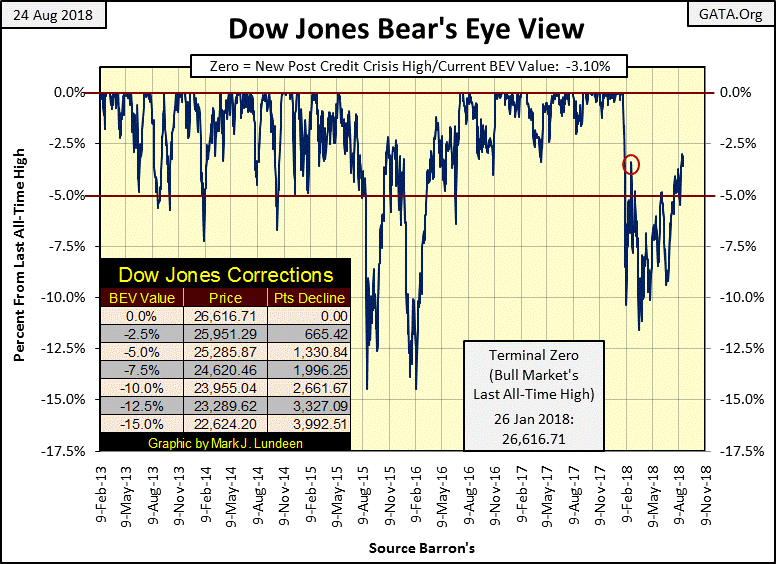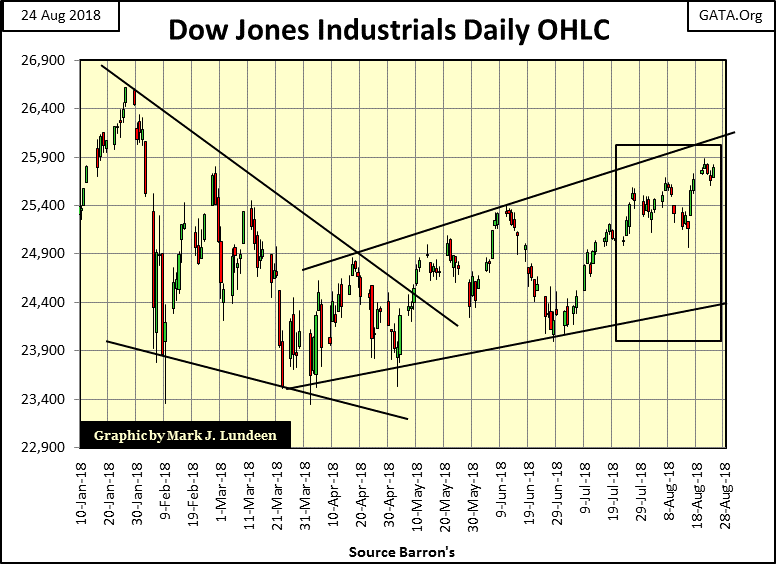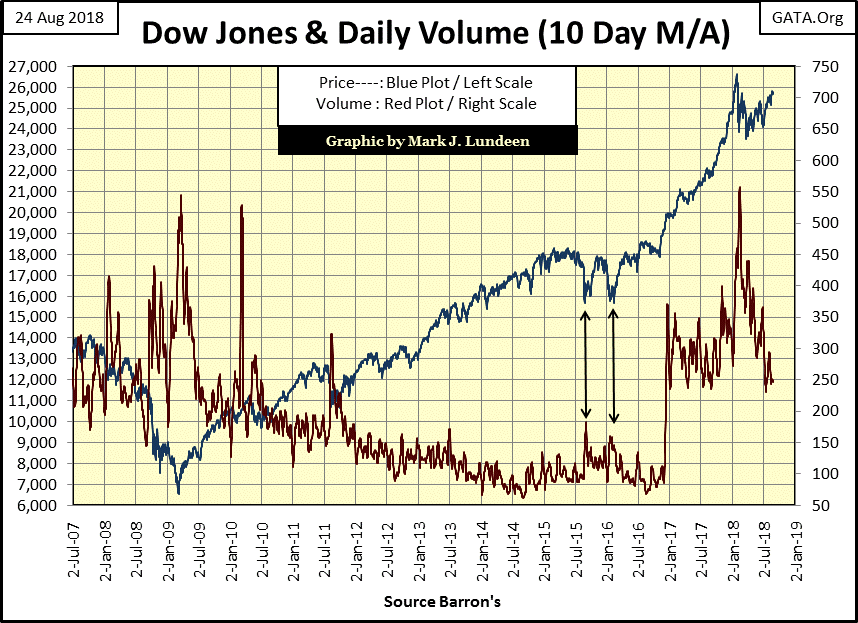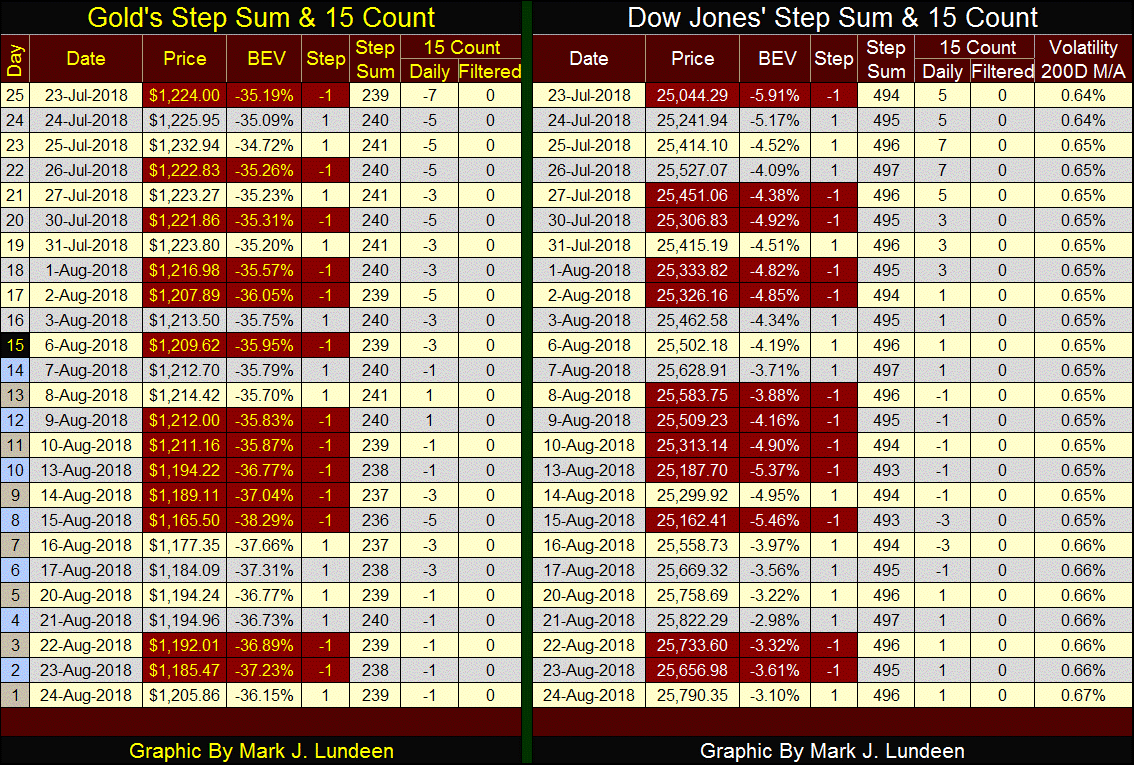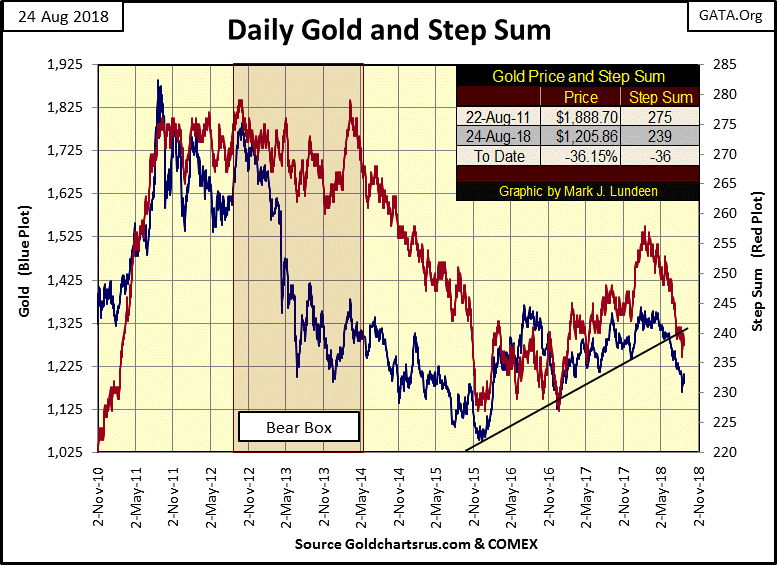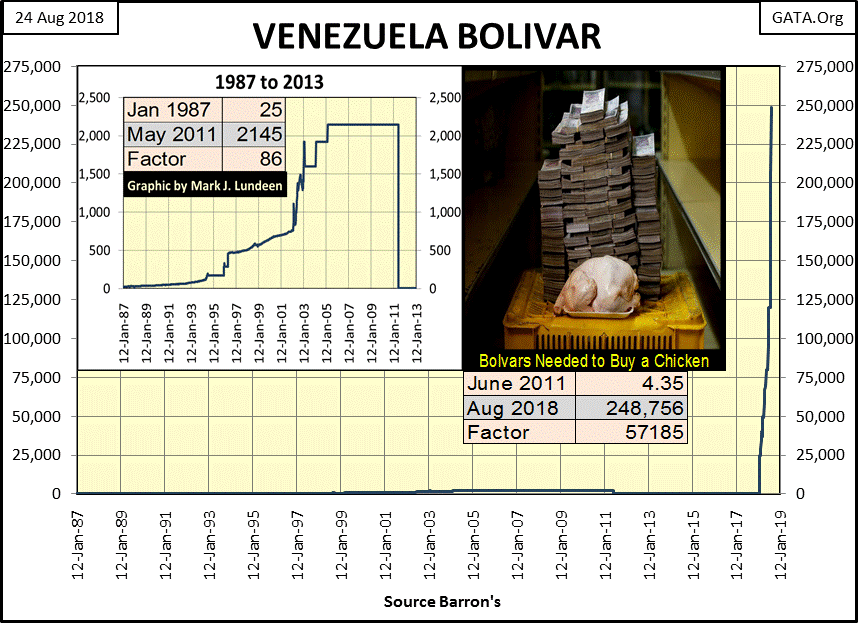Did Gold Hit Bottom On August 15th?
I’m going to take a three week break. I usually do so at this time each year as in the late summer markets become tedious. I struggle finding something interesting to write about. All that and the need to spend some time with my files to get them back up to speed requires that I take some time off. I’ll be back September 22nd.
Closing the week only -3.10% from its last BEV Zero, the Dow Jones Index is progressing towards a new all-time high in its BEV chart below as it cleared the -3.43% from late February (Red Circle). Only 3.10% from a new all-time high and as much time as it needs to do it. But if it hasn’t closed within 1% from its January 26th’s BEV Zero by the time I get back in late September, I’ll have to wonder why.
Here’s the Dow Jones in daily bars, heading towards it last all-time high of 26,616 seen on January 26th; heading upwards in baby steps is fine with me. That’s a gap of only 826 points from January’s last all-time high to where the Dow Jones closed today. That’s a little less than the Dow Jones has traveled since July 12th when it closed at 24,924.
The stock market is advancing perversely again, rising on declining trading volume. The Dow Jones (Blue Plot below) bottomed on March 23rd, and has been rising ever sense on declining trading volume (Red Plot). That’s unnatural.
If you believe in the law of supply and demand, you’d expect rising demand (rising trading volume) results in rising prices, and declining demand (declining trading volume) results in declining prices. From January 1900 to January 2000 (100 years) that was how the stock market worked. To be sure there were days, weeks and the rare occasional month that saw valuations rise or fall contrary to fundamental trends in trading volume. However, over the months and years of any advance or decline in the stock market, complementary trends in market valuations and trading volume held.
Bull markets saw rising demand as they drew in the public with the promise of easy money. Bear markets saw declining demand as the public withdrew from the markets after losing most, if not all of their life’s savings.
But all that changed after January 2000, where the stock market (using the Dow Jones as my proxy) typically advanced on declining trading volume, and declined on rising trading volume. This inversion of the law of supply and demand continued for sixteen years, until just after Donald Trump won the November 2016 election.
Look at the post March 2009 advance above. Trading volume saw an all-time high at its March 2009, -54% bear-market bottom, and then collapsed for five years as the Dow Jones recovered all of its sub-prime mortgage bear market losses, and then when on making one new all-time high after another. Except for the High-Tech market bottom of October 2002, no other major market advance from a bear market bottom has operated like this.
Record trading volume at bear market bottoms tells me that these were very liquid bottoms. If you wanted to sell you may not have liked the price you were offered, but there was always someone offering you a price for what you were selling.
The bear markets of the 20th century bottomed on greatly reduced trading volume; that means those bear-market bottoms were illiquid markets. In July 1932, or April 1942, or November 1974, you may have wanted to sell and discovered that not only that you didn’t like the price, but the price was from a few days ago with no current bid for what you were selling! But all that changed after January 2000.
What this tells us is how heavily involved the “policy makers” have been in the financial markets since January 2000. And today, seeing the Dow Jones once again rising upward towards another new all-time high on declining trading volume says nothing has changed – market valuations are still being managed.
As for gold, after this week’s trading its beginning to appear the $1,165.50 seen on August 15th (Day #8 table below) is the bottom of our current decline. On August 15th gold’s step sum bottomed at 236 as did its 15 count at -5.
When one looks at historical data quantitatively with metrics such as prices, a step sum, and the 15 count, data whose excitement has been washed away by the flow of time, one seeks turning points; bottoms and tops in the data. They’re always there to be found, extremes to the up or down side that were never again exceeded during any particular market advance or decline.
The same will be true for today’s market data. But unlike examining data from the Great-Depression Crash, examining today’s statistics one has to deal with the emotional aspect of being a participant in market history. Looking at markets through our hopes and fears is no way to make money.
I’d rather look at gold’s 15 count’s frequency distribution in the table below, noting how in the eighty-two trading sessions since May 1st, gold’s 15 count closed the day with positive values only twelve times (14.64%). For the other 85.36% of the past eighty-two days (70 days) the count was negative, with 28% (more than a quarter of the eight-two days) seeing the count at a -5 or -7.
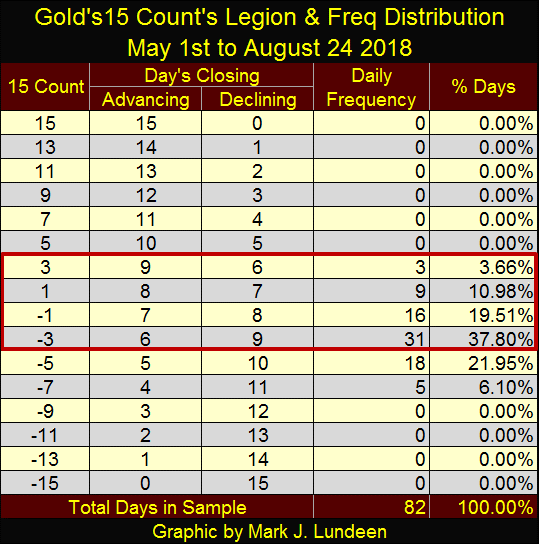
While these numbers aren’t historic, it’s obvious since May 1st gold has seen overwhelming selling pressure attempting to drive its valuation down. But gold close at $1,309.83 on May 1st, and closed last Friday at $1,205.83. So, all that for only a $103.97 (7.94%) decline in the price of gold over a fifteen week period?
Whether I’m right or wrong about the gold market seeing a bottom on August 16th, the truth will be seen in the coming weeks and months. But even if I’m ultimately proven wrong, and the low August 15th doesn’t hold, I can’t imagine the bears being able to force gold to fall below $1,100.
Moving down to gold’s step sum chart below, the current decline in the step sum began on February 1st at 257, over six months ago and bottomed on August 15th at 236. That’s a net of 21 down days in the past six months, which as you can see is a considerable decline in gold’s step sum. But it wasn’t until after May 2nd this selling program by the bears began having an impact on the price of gold. All this leads me to believe that gold (silver and the PM miners too) are markets that if left to their own fundamentals would have rather gone up than down since February 1st.
I’ll be missing in action until September 22nd; don’t be surprised if we see a strong bounce in the old monetary metals and their miners before I return.
NBC News published a story of how many bolivars it takes to purchase a chicken in Venezuela.
https://www.nbcnews.com/slideshow/see-how-many-bills-it-took-buy-chicken-venezuela-n902491
NBC’s photo of how many bolivars it took to purchase a chicken was so impressive I inserted it in the chart below – so sad. But this is what happens when economics and “monetary policy” are controlled by politics. And politics is always about the needs of the people, the people at the top that is.
And Venezuela’s monetary woes isn’t a rare episode in the history of “monetary policy.” Since Evita told the Argentinean people not to cry for her, they’ve had many opportunities to cry for themselves with several episodes of complete currency collapse since 1945. Monetary inflation have stolen the wealth saved by the common people in many Latin American countries in the past four decades, some very similar to what we see in Venezuela’s bolivar above.
Zimbabwe’s bout of monetary inflation from ten years ago was one to remember. As I recall their central bank finally issued a 10 trillion Zim-dollar note. South Africa, now under the control of the African National Counsel, a Communist (Marxist-Leninist) Party intends to follow in Zimbabwe’s path.
“Social Justice” in South Africa calls for driving all the white people from their boarders, especially their farmers. Zimbabwe also did this, giving their farm land to political favorites. Famine broke out within a year. Should South Africa follow in Zimbabwe’s footsteps, and eventually they will, the results won’t be any different.
Is there a more miserable “social-economic theory” than is socialism / communism? It’s been around since the French Revolution. During the 20th century it spread like a fungus over the face of the Earth until in the 1970s, over half of the world’s population was governed by communists. Forty years later this is no longer so for the good reason that communism doesn’t work.
The last global stronghold for communists isn’t communist China but in the Western educational establishment. Academia on both sides of the Atlantic Ocean is staffed by people who truly have a learning disability when it comes to their politics and solutions to society’s problems.
Their current focus is on “gender studies”, where apparently they are intent on proving they are as clueless on human biology as they have been, and still are on economics.
Why parents send their children to college is a mystery to me, though I understand why Washington still fully funds “higher education.” After an $80,000 four year study in a college “critical studies” program (cost carried by student), students may not be employable but they will vote Democrat.
Even in the hard sciences these commies have had an impact. From astrophysics to quantum mechanics, empirical research has led science to a point where accepting a creator from outside our universe’s space-time continuum is the most logical hypothesis. But unless a professor in science has a Nobel Prize in their resume, they best keep such conclusions under their hats for fear of these pinkos attacking them, and ruining their careers for their honest opinions.
Mark J. Lundeen






